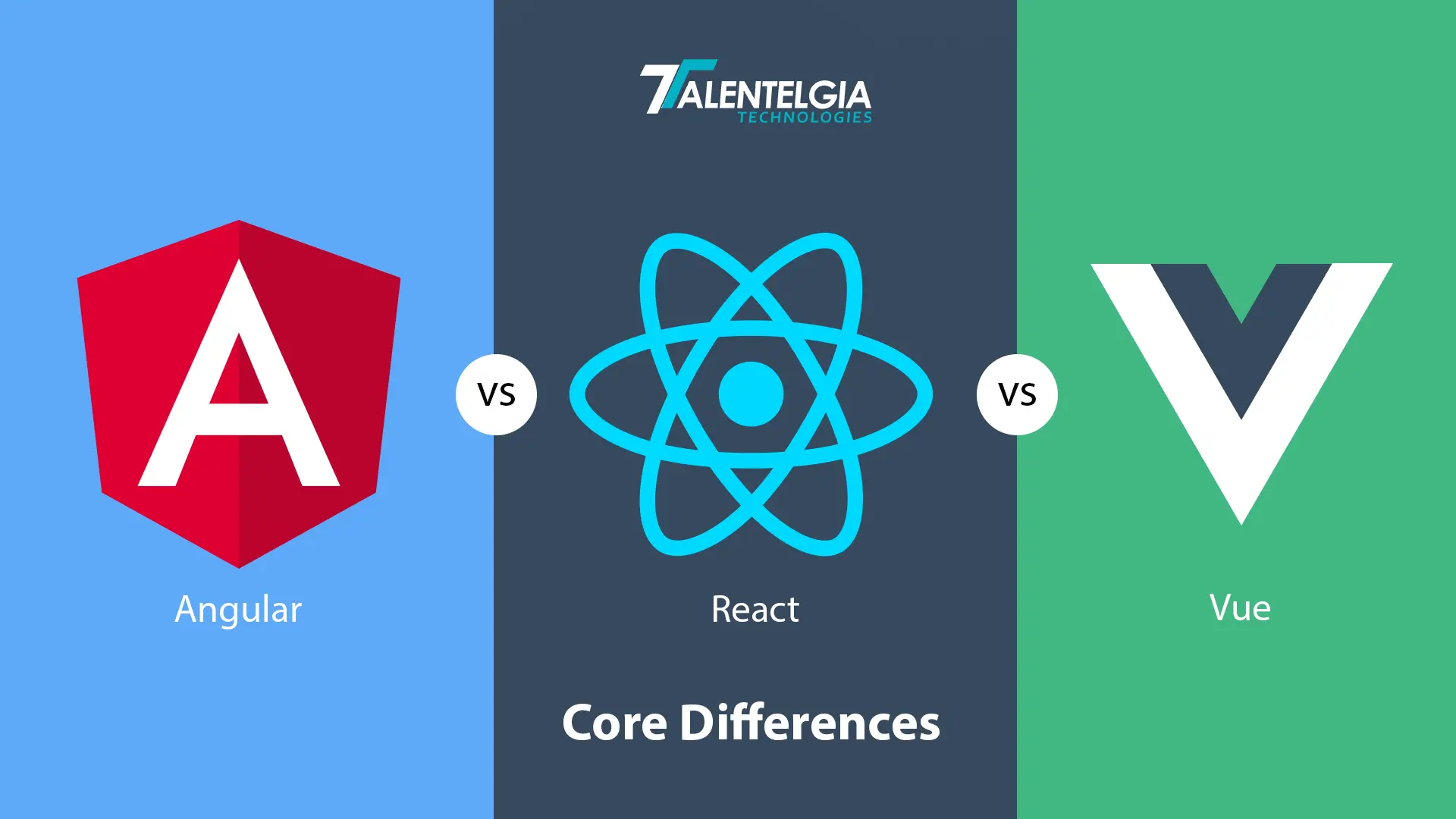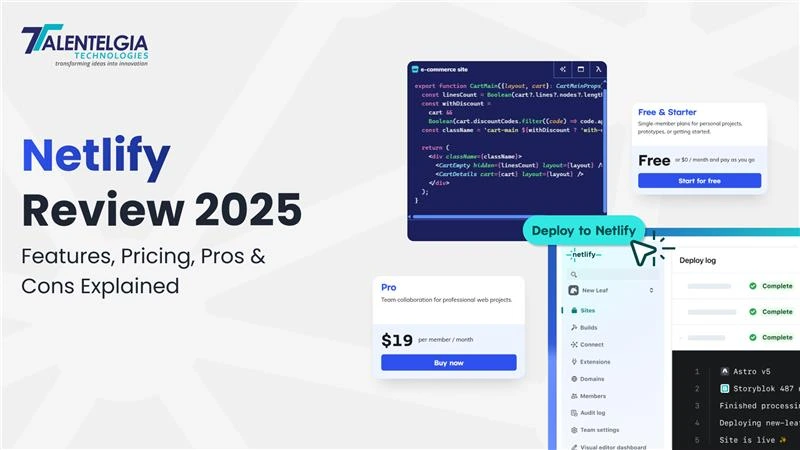The debate over the best front-end framework is ongoing, each side comes with strong opinions. Of the dominant technologies, namely React, Angular, and Vue, each of them has unique features and advantages with relevant trade-offs. React is developed and maintained by Meta, gaining huge support due to the flexibility of its library and its robust ecosystem. Meanwhile, Angular, maintained by Google, comes as an opinionated full-fledged framework with robust tooling and built-in features inside that make it more appealing for those who want an all-in-one solution. Developed by Evan You, Vue is highly spoken of in terms of its simplicity and integration ease, providing a lightweight solution accompanied by extraordinarily high adaptability. Let’s learn the primary differences in Angular vs React vs Vue.
Recently we created a poll on our Talentelgia social media and took input from our developers and our fellow community developers about these frameworks. Out of 464 total votes, React emerged as the clear favorite, showing that 303 developers favored React, 88 preferred Angular, and 73 chose Vue.
Let’s explore the details of each framework and see which one might come out on top in the long run.
React: The Front-Runner
React is undeniably the most popular of the three front-end frameworks, holding the largest market share among developers. This is clear from recent poll results, where React garnered the most votes. Its widespread use is bolstered by Meta (formerly Facebook), which has heavily invested in the framework’s development and upkeep.
This corporate support has contributed to React’s extensive ecosystem, regular updates, and strong community presence.
One of the real strengths of React is its simplicity and flexibility. This means any component can be written with mixed HTML and JavaScript using JSX, which really makes it very intuitive and manageable. This approach streamlines development by producing more readable and maintainable code, leading to quicker development cycles and easier debugging.
Community Insights:
One of our developers said: “JSX is too simple of a paradigm to want to do anything else.” This comment reflects the sentiment that JSX’s straightforward approach can be so effective that it sets a high standard for other frameworks.
React expert: “React. Because it is backed by Meta and is high on backwards compatibility.” This highlights the value developers place on the framework’s backing and its ability to maintain compatibility with previous versions, which can ease the upgrade process and reduce technical debt.
React’s hook system, while powerful, has received mixed reviews. Some developers appreciate its capabilities, as it simplifies state management and enables cleaner code composition. However, others find it messy and challenging to compose correctly, particularly when dealing with complex logic or adhering to the rules of hooks.
Pros of React Framework
Component Reusability: Since React is an integral component-based architecture, it helps develop reusable UI components. This keeps the code modular, making many things easy during development and maintenance.
Virtual DOM: It improves the performance of the application. The reason being, it updates and renders changes only to the parts of the real DOM that have changed.
Strong Community Support With its enormous amount of resources, tools, libraries, and support, the speed of development is increased by helping in solving issues.
Cons of React Framework
Learning Curve: It has introduced concepts like JSX, hooks, state management, etc., are pretty difficult for a fresher and require a little steeper learning curve than some of the other frameworks.
Frequent Updates: It is the frequent updating of React that may easily land one in a compatibility issue and joined with endless adaptation and learning to move according to the latest changes and best practice.
Standard Code: Initial setup and configuration can involve a lot of boilerplate code, especially when integrating with other tools and libraries, which can be cumbersome.
Future Outlook
In the short to mid-term (3-5 years), React seems poised to maintain its lead due to its extensive ecosystem and widespread adoption. However, as technology evolves, new paradigms might emerge, potentially overshadowing React’s current dominance. Frameworks like Svelte and Solid are gaining attention for their performance and simplicity, indicating that the landscape of front-end development might continue to diversify. As the industry progresses, developers will need to stay adaptable and open to adopting these emerging technologies.
Angular: The Enterprise Favorite
Created by Google, Angular is a framework that offers a powerful, all-in-one solution. It is especially popular in business environments where durability and long-term service are important. Although powerful, Angular has a steeper learning curve compared to React and Vue, which can discourage new developers. But strong community support and extensive knowledge help overcome these problems. Apart from that, dependency injection and reactive programming are already embedded in Angular, thus making it a very good choice for large-scale applications.
Community Insights:
Developer: “I have a soft spot for Angular. React has gone off the deep end with RSC and Next and Remix.”
Angular Expert: “No, it’s just not as ‘hot’ anymore but still heavily used especially in enterprise and B2B contexts.”
Angular’s integration with TypeScript and its conceptual frameworks provide similar improvements but may be viewed as limiting by some developers. But Angular’s comprehensive toolset and powerful features make it a good choice for large organizations. Going forward, Angular will likely continue to be a dominant player in an environment where long-term support and maintenance is required. As the framework continues to evolve, performance and development improvements could address some of the current criticisms and ensure it is relevant to the growing competitive landscape.
Pros of Angular
Comprehensive Framework: Angular provides an end-to-end solution with many features inbuilt, such as dependency injection, two-way data binding, and a powerful templating system. In the process, this reduces the need for additional libraries.
TypeScript Integration: Angular uses TypeScript, providing robust typing and advanced features to help developers catch mistakes early in the development process and maintain clean, scalable code.
A Great Community with Good Support: Created by Google and supported by a strong community, Angular has thorough documentation, frequent updates, and a great set of resources to fix or learn anything.
Cons of Angular
Steep Learning Curve: It’s rather hard to learn and master Angular and all its complexity, and it has made the framework pretty hard to grasp for a beginner in the early days of development.
Opinionated Architecture: By having a more rigid structure and rigid conventions, Angular can be seen as restrictive to some developers who have used more flexible and less prescriptive frameworks.
Performance Overhead: Due to its huge size and complexity, the framework raises performance-related issues in the case of small applications. In that case, its comprehensiveness is overkill.
Future Outlook:
Angular’s integration with TypeScript and its conceptual frameworks provide similar improvements but may be viewed as limiting by some developers. But Angular’s comprehensive toolset and powerful features make it a good choice for large organizations. Going forward, Angular will likely continue to be a dominant player in an environment where long-term support and maintenance is required. As the framework continues to evolve, performance and development improvements could address some of the current criticisms and ensure it is relevant to the growing competitive landscape.
Vue: The Rising Star
Vue is known for its simplicity and ease of learning, making it popular with small teams and individual developers. Its success allows developers to gradually adopt it, which is a huge advantage for projects looking to evolve. As Vue continues to grow in popularity, its emphasis on simplicity and flexibility positions it well for future success. With its expanding environment and strong community, Vue is poised to become an increasingly important choice for new and ongoing projects. Its flexibility and ease of integration ensure that it remains the primary choice in the ever-evolving world of front-end systems.
Community Insights:
Developer: “Vue fanboys are always linking benchmarks and acting like extremists but every time I see a Vue project in the wild it’s a mess.”
Vue Experts: “Vue’s gentle learning curve and clear documentation make it a great choice for beginners.
Despite its advantages, Vue’s smaller ecosystem and community support compared to React and Angular can be a drawback. However, its simplicity and ease of integration make it a compelling choice for many.
Pros of Vue
Gentle Learning Curve: Vue’s straightforward and intuitive design makes it accessible for developers of all skill levels, allowing for a smooth learning process and rapid development.
Flexibility and Incremental Adoption: Vue’s progressive framework allows developers to integrate it into existing projects gradually, making it easier to adopt and scale as needed without a complete overhaul.
Clear Documentation and Community Support: Vue is known for its well-organized documentation and strong community support, which helps developers quickly find solutions and best practices.
Cons of Vue
Smaller Ecosystem: Vue is small in its ecosystem compared to React and Angular; therefore, it might not have libraries and third-party tools.
Limited Corporate Backing: Although Vue holds a very strong community backing, it does not have sponsorship by large tech companies like React (Facebook) or Angular (Google), hence its long-term supportiveness and evolution are affected.
Performance Concerns in Large Applications: This is where Vue’s performance may turn out to be less optimized, especially in huge, complex applications. This is relative to the frameworks that have more robust tooling and built-in features for handling such scale.
Future Outlook:
The future of Vue looks promising, especially for small and medium-sized projects. Its focus on simplicity and flexibility has earned strong support from the community and shows that it will improve in these areas. The biggest problem that Vue may encounter is in bigger and more complex applications. As it evolves, its ability to overcome these limitations will be important for its long-term survival.
Angular vs React vs Vue: Primary Differences
Now, let’s understand the primary difference between Angular vs. React vs. Vue through this table based on several parameters. This will give a snapshot of the key features of every framework so that you can decide which one is best for your needs and preferences. You can use this to quickly evaluate which framework is best for your needs based on your specific process.
| Parameter | Angular | React | Vue |
| Type | Full-fledged MVC framework | Library for building UI components | Progressive framework for building UIs |
| Language | TypeScript (JavaScript) | JavaScript | JavaScript |
| Learning Curve | Steeper, due to its comprehensive structure | Moderate, especially for JSX | Gentle, due to its simple syntax |
| Community Support | Large and established community | Large and active community | Growing, with enthusiastic developers |
| Flexibility | Opinionated structure | Highly flexible | Moderately flexible |
| Performance | Generally good | Excellent | Good, with smaller bundle sizes |
| Popularity | Widely used in enterprise applications | Very popular, especially in web development | Increasing popularity among developers |
| Integration | Offers everything needed in the box | Requires external libraries for full functionality | Offers most features out-of-the-box |
| Componentization | Strongly emphasizes components | Native support for components | Component-based architecture |
| Examples | Alibaba and Xaomi |
Conclusion
In the near future, React appears to be the dominant force, thanks to its large community, extensive ecosystem, and backing by Meta. Angular continues to be a strong contender, especially in the enterprise space, with its robust features and TypeScript integration. Vue, gaining traction with its simplicity and ease of use, remains a favorite among smaller teams and individual developers. However, the ever-evolving nature of web development means that today's leaders could be replaced by tomorrow's innovations. It will therefore become very important for developers to remain adaptable and prepared for changing trends.
However, in this field of continuous evolution, leaders in web development can be superseded by tomorrow's innovations. It will therefore become very important for developers to remain adaptable and prepared for changing trends.


 Healthcare App Development Services
Healthcare App Development Services
 Real Estate Web Development Services
Real Estate Web Development Services
 E-Commerce App Development Services
E-Commerce App Development Services E-Commerce Web Development Services
E-Commerce Web Development Services Blockchain E-commerce Development Company
Blockchain E-commerce Development Company
 Fintech App Development Services
Fintech App Development Services Fintech Web Development
Fintech Web Development Blockchain Fintech Development Company
Blockchain Fintech Development Company
 E-Learning App Development Services
E-Learning App Development Services
 Restaurant App Development Company
Restaurant App Development Company
 Mobile Game Development Company
Mobile Game Development Company
 Travel App Development Company
Travel App Development Company
 Automotive Web Design
Automotive Web Design
 AI Traffic Management System
AI Traffic Management System
 AI Inventory Management Software
AI Inventory Management Software
 AI Software Development
AI Software Development  AI Development Company
AI Development Company  AI App Development Services
AI App Development Services  ChatGPT integration services
ChatGPT integration services  AI Integration Services
AI Integration Services  Generative AI Development Services
Generative AI Development Services  Natural Language Processing Company
Natural Language Processing Company Machine Learning Development
Machine Learning Development  Machine learning consulting services
Machine learning consulting services  Blockchain Development
Blockchain Development  Blockchain Software Development
Blockchain Software Development  Smart Contract Development Company
Smart Contract Development Company  NFT Marketplace Development Services
NFT Marketplace Development Services  Asset Tokenization Company
Asset Tokenization Company DeFi Wallet Development Company
DeFi Wallet Development Company Mobile App Development
Mobile App Development  IOS App Development
IOS App Development  Android App Development
Android App Development  Cross-Platform App Development
Cross-Platform App Development  Augmented Reality (AR) App Development
Augmented Reality (AR) App Development  Virtual Reality (VR) App Development
Virtual Reality (VR) App Development  Web App Development
Web App Development  SaaS App Development
SaaS App Development Flutter
Flutter  React Native
React Native  Swift (IOS)
Swift (IOS)  Kotlin (Android)
Kotlin (Android)  Mean Stack Development
Mean Stack Development  AngularJS Development
AngularJS Development  MongoDB Development
MongoDB Development  Nodejs Development
Nodejs Development  Database Development
Database Development Ruby on Rails Development
Ruby on Rails Development Expressjs Development
Expressjs Development  Full Stack Development
Full Stack Development  Web Development Services
Web Development Services  Laravel Development
Laravel Development  LAMP Development
LAMP Development  Custom PHP Development
Custom PHP Development  .Net Development
.Net Development  User Experience Design Services
User Experience Design Services  User Interface Design Services
User Interface Design Services  Automated Testing
Automated Testing  Manual Testing
Manual Testing  Digital Marketing Services
Digital Marketing Services 
 Ride-Sharing And Taxi Services
Ride-Sharing And Taxi Services Food Delivery Services
Food Delivery Services Grocery Delivery Services
Grocery Delivery Services Transportation And Logistics
Transportation And Logistics Car Wash App
Car Wash App Home Services App
Home Services App ERP Development Services
ERP Development Services CMS Development Services
CMS Development Services LMS Development
LMS Development CRM Development
CRM Development DevOps Development Services
DevOps Development Services AI Business Solutions
AI Business Solutions AI Cloud Solutions
AI Cloud Solutions AI Chatbot Development
AI Chatbot Development API Development
API Development Blockchain Product Development
Blockchain Product Development Cryptocurrency Wallet Development
Cryptocurrency Wallet Development About Talentelgia
About Talentelgia  Our Team
Our Team  Our Culture
Our Culture 
 Healthcare App Development Services
Healthcare App Development Services Real Estate Web Development Services
Real Estate Web Development Services E-Commerce App Development Services
E-Commerce App Development Services E-Commerce Web Development Services
E-Commerce Web Development Services Blockchain E-commerce
Development Company
Blockchain E-commerce
Development Company Fintech App Development Services
Fintech App Development Services Finance Web Development
Finance Web Development Blockchain Fintech
Development Company
Blockchain Fintech
Development Company E-Learning App Development Services
E-Learning App Development Services Restaurant App Development Company
Restaurant App Development Company Mobile Game Development Company
Mobile Game Development Company Travel App Development Company
Travel App Development Company Automotive Web Design
Automotive Web Design AI Traffic Management System
AI Traffic Management System AI Inventory Management Software
AI Inventory Management Software AI Software Development
AI Software Development AI Development Company
AI Development Company ChatGPT integration services
ChatGPT integration services AI Integration Services
AI Integration Services Machine Learning Development
Machine Learning Development Machine learning consulting services
Machine learning consulting services Blockchain Development
Blockchain Development Blockchain Software Development
Blockchain Software Development Smart contract development company
Smart contract development company NFT marketplace development services
NFT marketplace development services IOS App Development
IOS App Development Android App Development
Android App Development Cross-Platform App Development
Cross-Platform App Development Augmented Reality (AR) App
Development
Augmented Reality (AR) App
Development Virtual Reality (VR) App Development
Virtual Reality (VR) App Development Web App Development
Web App Development Flutter
Flutter React
Native
React
Native Swift
(IOS)
Swift
(IOS) Kotlin (Android)
Kotlin (Android) MEAN Stack Development
MEAN Stack Development AngularJS Development
AngularJS Development MongoDB Development
MongoDB Development Nodejs Development
Nodejs Development Database development services
Database development services Ruby on Rails Development services
Ruby on Rails Development services Expressjs Development
Expressjs Development Full Stack Development
Full Stack Development Web Development Services
Web Development Services Laravel Development
Laravel Development LAMP
Development
LAMP
Development Custom PHP Development
Custom PHP Development User Experience Design Services
User Experience Design Services User Interface Design Services
User Interface Design Services Automated Testing
Automated Testing Manual
Testing
Manual
Testing About Talentelgia
About Talentelgia Our Team
Our Team Our Culture
Our Culture


















 Write us on:
Write us on:  Business queries:
Business queries:  HR:
HR: 




